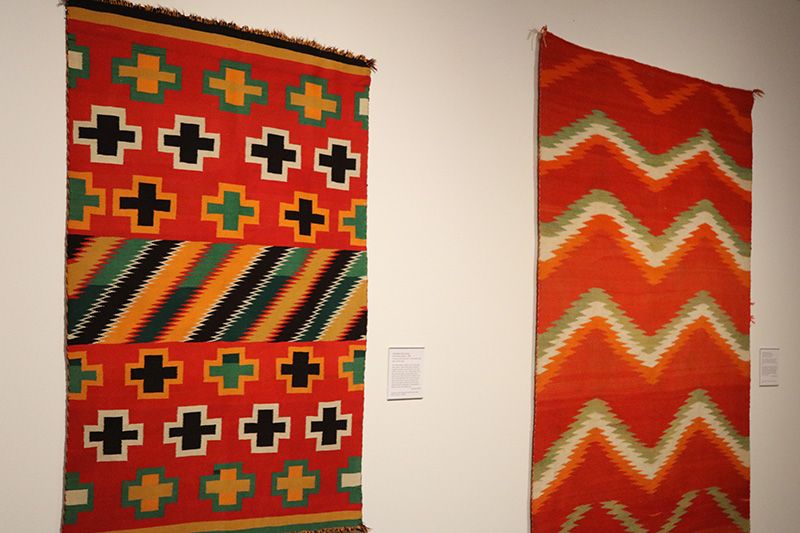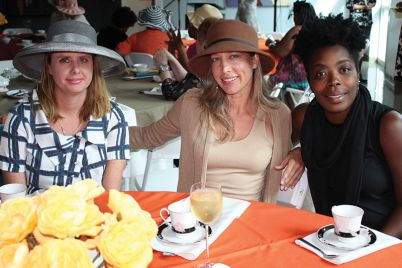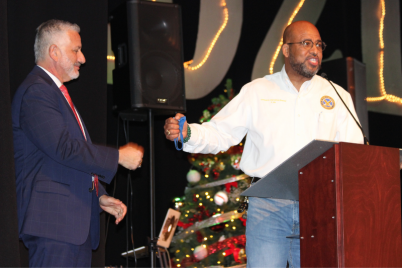‘Color Riot! How Color Changed Navajo Textiles’ features more than 80 woven rugs, blankets and pillowcases created during the Transitional Period in Navajo weaving, from 1875 to 1910.
BY J.A. JONES, Staff Writer
ST. PETERSBURG — The art of Navajo weavers is on view during the special exhibition of “Color Riot! How Color Changed Navajo Textiles,” through March 14 at the St. Petersburg Museum of Fine Arts.
The exhibit features more than 80 woven rugs, blankets and pillowcases created during the Transitional Period in Navajo weaving, from 1875 to 1910. But it is impossible to separate the beauty of the textiles created during the Transitional Period from the horror of the history that preceded it.
Because the beauty of the highly individualized and boldly colored weavings were created in a period following the horror, disruption and forced relocation of the Navajo, or Diné in their language, people. Just a decade before the Transitional period began, the Navajo/ Diné were forced from the Four Corners region of present-day Northeastern Arizona as they undertook what is called the “The Long Walk.”
During this tragic five-year episode, the Navajo people were forced to surrender and march to a military camp, Fort Sumner, in eastern New Mexico during the scorched earth takeover called “manifest destiny” – as white Americans rolled across the West.
Occurring within 53 forced marches between 1864 and the end of 1866, more than 10,000 Navajos began the perilous and brutal walk – with over 2,000 Navajos dying on their way to the prison camp, herded along like cattle by a heartless U.S. Army.
Finally reaching the camp, in an area called Bosque Redondo, they were imprisoned for two years. The Navajo refer to the terror of this period of ethnic cleansing as “Hweeldi” – place of suffering.
After two more brutal years, the Bosque Redondo “experiment” was an admitted failure in its plan to force Native Americans into labor without adequate food, water or clothing. Following the death of many more of the Diné people, the U.S. established the Treaty of 1868, and the Navajo were allowed to return to their homelands.
In exchange for an agreement to remain on the reservation homelands given to them, they agreed to allow U.S. railroads to be built through their reservation and for U.S. citizens to travel through their lands without incident.
Before the Bosque Redondo, the Navajo had enjoyed a centuries-long tradition, and thriving industry of weaving blankets used as body wraps for warmth, as saddle blankets and often more expensive weavings purchased as “chief blankets” by other tribes that came to a halt during the desolation of Bosque Redondo. Their cattle had been killed, and they were forced to a barren land with barely enough food for themselves.
When they returned to their homelands, they were given a new breed of cattle and new dyes in new colors. But with their markets and former trading alliances with other tribes and Mexican markets uprooted by their relocation, they were no longer weaving for other markets but for themselves, their own creative desires and expressions. By 1871, they were weaving the blankets on display in “Color Riot!”
This stunning exhibition traveled from the Heard Museum in Phoenix, which has a mission to present, interpret and advance the protection and exposure of indigenous art. The exhibit resulted from a Mellon Foundation grant to support a fellowship program that which three Navajo fellows to the museum for three years to help curate the show.
Each of the fellows — Velma Kee Craig and Ninabah Winton, both Navajo, and Natalia Miles, who is Navajo/San Carlos Apache/ Akimel O’otham — had statements included on the opening walls of the exhibit.
Ninabah Winton shared:
“During the Transitional Period, from 1875 to 1910, and primarily in the face of concurrent assimilationist policies, Navajo weavers were experimenting wildly and without reserve, and the products of their looms seem to scream in a collective explosion of voices and tones as active reminders – We are still here.
We are still creating and We have already adapted.”
Velma Kee Craig wrote:
“The textiles presented are creations of weavers who wove for themselves – they are vibrant and unrestrained in both color and design. They were woven after a time when Navajo men, women, and children were themselves were marched hundreds of miles out of their homeland to be held in an internment camp. These weavers knew firsthand the looming heaviness and darkness of mass erasure, and more so than at any previous time, created for themselves, for their families, and for the 2.500 Navajos who never made it home again.”
In her statement, Natalia Miles noted:
“I did not know that the term ‘eyedazzler’ was originally used…as a description of these colorful, ‘unmarketable’ weavings that briefly thrived after Hweeldi (the Long Walk and Bosque Redondo imprisonment). In my mind, the term had always been meant as pleasant and positive, and I find it humorous that traders gave these ‘undesirable’ weaving such an attractive name. In these weavings, there is a true sense of the artists’ unbridled creativity and freedom in their color schemes and layouts.”
Ann Marshall, director of research at the Heard, and scholar Carol Ann Mackay, a collector of Navajo textiles, also co-curated the exhibit. The exhibit also includes several weavings by contemporary artists.
“Color Riot! How Color Changed Navajo Textiles” at the MFA is made possible by Tinney Rug Cleaners, State of Florida Division of Cultural Affairs and the Florida Council on Arts and Culture, with additional support from Bank of America and the Garth Family Foundation.
Admission tickets must be reserved online for timed entry in accordance with the Museum’s COVID-19 safety measures. Visit https://mfastpete.org/ for more information.








